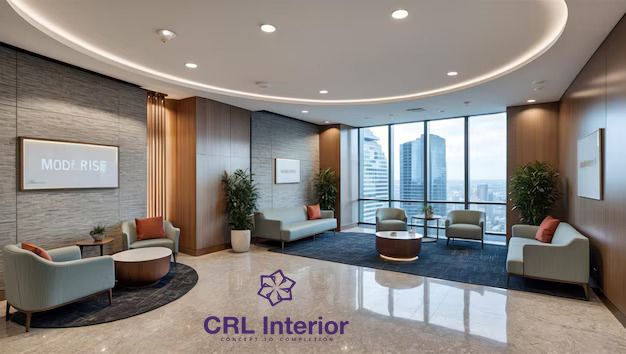With the evolution of the real estate industry, office space is becoming increasingly valuable. In 2024, real estate office interior design is more than just looking good; it is also about creating environments for collaboration, productivity, and brand identity rejuvenation. In this article, we will go over the latest trends in interior design for real estate office interiors, bringing fresh ideas on how places can be transformed into interesting and effective workspaces.
Embracing Open Floor Plans
Indeed, open floor plans have dominated the landscape of real estate office interior design. These layouts contribute to the demise of traditional office cubicle space planning and private offices, while allowing for open collaboration and communication among team members.
In 2024, the trend is to create spaces that can be easily adapted for a variety of purposes, such as meetings, brainstorming sessions, and social gatherings. The flexibility it provides goes a long way toward meeting the diverse needs of a real estate team and encouraging creativity and collaboration. Movable furniture and modular designs are easily adaptable to other office configurations to accommodate a variety of activities.
Areas designated with comfortable seating arrangements and whiteboards encourage informal discussions, whereas quiet areas, such as soundproof booths or a quiet area, promote focused work. Furthermore, breakout zones with a coffee bar or snack facilities can encourage informal conversations and give teams more momentum.
Sustainable Design Decisions
Sustainability is still a major focus in office design today, and it extends to the real estate office interior. In 2024, interior design will focus on eco-friendly materials and energy-efficient designs. Real estate firms are beginning to recognize the importance of creating spaces that reduce environmental impact while also improving employee wellness.
Biophilic design, which includes indoor plants, living walls, and natural light in its construction, improves aesthetics, air quality, and employee morale. To increase the office’s sustainability, the furniture and fixtures can be made from reclaimed or recycled materials.
Furthermore, LED lighting and smart controls can reduce energy consumption significantly while also creating a pleasant ambiance. The emphasis on water conservation through low-flow fixtures and the manipulation of rainwater collection systems both contribute to the sustainability effort.
Focus on Employee Well-being
By 2024, employee well-being will have taken center stage in real estate office interior design. Companies, realizing that a good workspace leads to increased employee productivity, are now advocating for designs that promote mental and physical health. This is accomplished by investing in ergonomic chairs and desks that provide comfort and reduce stress on the body.
Large windows or skylights that let in natural light help to lift one’s mood and foster a connection with the outdoors. Designating areas for relaxation, meditation, or physical activity helps them recharge and reduces stress, resulting in a more productive workforce.
This can be further enhanced by including wellness-focused facilities such as standing desks, treadmill desks, and yoga spaces. Community gardens or outdoor workspaces can also be established to provide refreshing breaks while strengthening their connection with nature.
Branded Personalization
In 2024, real estate companies will focus on office design to fully represent their brand and culture. Personalized branding not only improves the customer experience but also fosters team pride and cohesion. Thematic design elements, logos, and imagery are used throughout the office to establish a consistent identity for clients and employees alike. Outstanding practice confidence is demonstrated through awards, testimonials, and case studies displayed throughout the office.
Designate a space for clients, including inviting reception areas that leave a lasting impression and comfortable meeting rooms that demonstrate your firm’s seriousness in providing less-than-excellent service. Furthermore, incorporating local art and cultural elements into the office design can help to create an identity that better connects the firm to the community and demonstrates its commitment to local values and initiatives.
Conclusion
In the latter half of 2024, future real estate office interior design ideas will include collaboration, sustainability, well-being, technology, personalized branding, and flexible workspaces. By implementing these forward-thinking strategies, real estate firms can create spaces that are easily accessible and functional in service to attract clients while also assisting them in maintaining employee satisfaction and productivity. Whether you’re redesigning a small real estate office interior or planning a larger one, these tips will help you create an office that’s both slick and effective. Take advantage of such design ideas and stay ahead of the competition in the real estate market while
